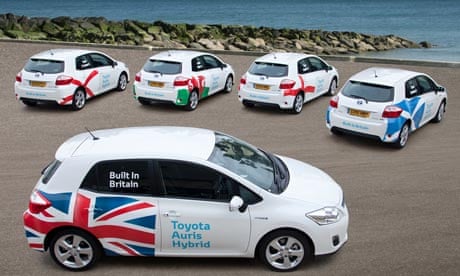I found myself thinking of Toad of Toad Hall on Saturday, as the RAC’s first ever eco-car rally sputtered into existence in Brighton, with me at the wheel of vehicle number 46.
What would he have made of this line-up? Would it have left him flat on his back in the middle of the road, dazed, bedazzled, and murmuring “poop poop” to himself? The petrol-guzzling cars of his infatuation were away in London gearing up for the annual London to Brighton rally on Sunday. They are still objects of great beauty; hand-crafted, Heath Robinson-style vehicles without roofs, indicators, and in at least one case with a tiller instead of a steering wheel. There is something about the infinite love with which these cars are made and maintained, something about their eccentricity which will always make them worthy of a “poop poop” or two.
But what of this peculiar new eco-generation? Are these “the new pioneers of motoring,” as Ben Cussons, chairman of the motoring committee at the RAC described them? They’re certainly an odd mix of electric plug-in, electric hybrid and hydrogen fuel cell vehicles, as well as a few with internal combustion engines which have been adapted for extreme fuel efficiency.
Gordon Murray’s ultra-efficient petrol-fuelled T25 is lined up alongside BMW’s Efficient Dynamic saloon, an electric MG and cars from Mercedes, Volkswagen, Nissan and Toyota. These cars represent the kind of mix which many pundits think will dominate our roads in 20 years or so, as petrol becomes more and more expensive and the infrastructure is built to support alternative fuels.
But can they inspire the same love as those that went before?
They certainly seem to be inspiring the same competitive spirit. The winner, it turns out, will not be the car which goes the fastest, but the one which uses the least energy, and there are already jealous murmurings around me: I overhear one man complaining that he’s been given an extra passenger because “that’s going to stuff our weight”. Richard Seymour, the Toyota technical expert with whom I’m driving, is advising the other Toyota drivers to turn off air conditioning, the radio, the lights, and generally drive in the most eco-friendly way possible. “If you angle your air vents straight on, that will stop them acting as a brake too,” he says, and he is only half-joking.
There is the usual buzz at the starting grid, but it’s odd with the lack of revving engines. Instead parents are having to be particularly careful of their children as electric cars surge up silently behind them. My sons have come to wave me off and are gawping at the three Teslas and Dale Vince’s Nemesis.
Everyone is looking under bonnets at strange new configurations, and then we are off, one at a time, with 30-second delays between each departure.
I’m with Richard in a Toyota prototype Fuel Cell Hybrid Vehicle which is so brand new that we’re not even allowed to properly compete, because the laboratory won’t release the technical data just yet.
It’s hydrogen powered; the hydrogen generates electricity which can either go into the battery or straight into the electric motor. It has a range of about 500 miles (which is handy because I think the nearest hydrogen refuelling station is in Birmingham), a top speed of 96mph, and is housed in an American-built Highlander body. It’s also so automatic that you hardly know you’re driving after a few minutes.
And then it’s just like a normal rally, with people on corners waving us on, and the usual jostling between competitors and the cheery spotting of other rally drivers. For a while we’re behind the Honda Clarity, also a hydrogen vehicle. I ponder the odds of one hydrogen car crashing into another, what might happen, and worse of all, (the car I’m driving is worth steeply upwards of half a million pounds), what the insurance claim would look like.
London is reached in good time and Volkswagen win the overall trophy (boo hiss). Prizes are handed out, Richard and I pat each other on the back, and say goodbye. Crowds have gathered again, just as they did in Brighton, to see these strange vehicles of the future, and to see that, strangely enough, they don’t look quite as much like space ships as might have been expected. Give it a hundred years and they might be welling up tears of nostalgia at the sight of a Prius too. Poop poop!

Comments (…)
Sign in or create your Guardian account to join the discussion